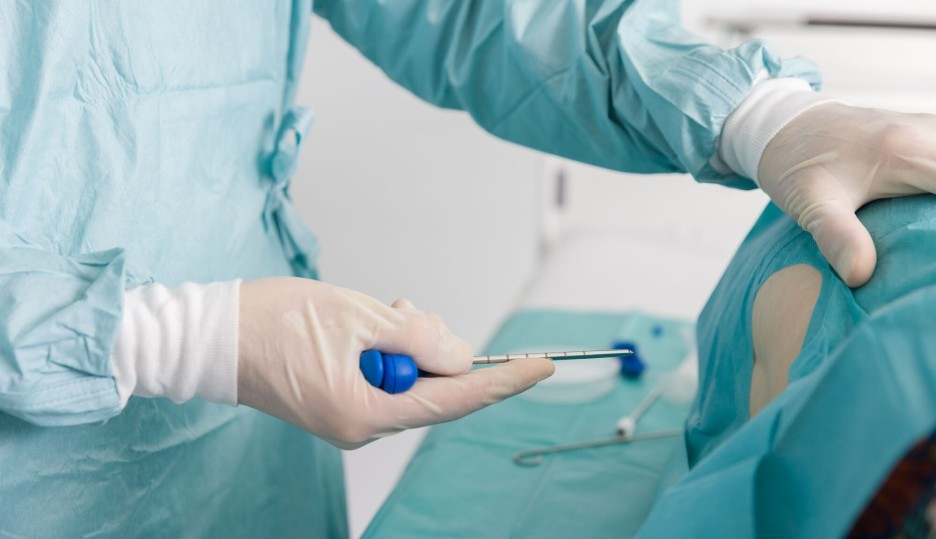Available sampling techniques
-
CHDR offers an in-house bone marrow sampling procedure for early-phase clinical trials. Bone marrow sampling provides valuable insights into immune cell behavior, aiding research in haemato-oncology, solid tumors, and autoimmune diseases. The procedure, which includes aspiration and biopsy, enables comprehensive analysis of bone marrow cells, including genomic, histopathological, and cytogenetic studies. A validation study we conducted in 2022 in healthy volunteers indicated that the procedure was well-tolerated, with many expressing a willingness to participate again in future studies.
-
At CHDR, we offer extensive experience in cerebrospinal fluid (CSF) sampling for early-phase clinical trials, conducting lumbar punctures in both healthy volunteers and patients with various conditions. Our clinical research unit is equipped to conduct hundreds of single lumbar punctures annually, consistently delivering high-quality CSF samples and keeping post-puncture headaches below 2%. Our highly-trained team of physicians, including two in-house neurologists, is supported by dedicated nursing staff and backed by the expertise of the anaesthesiology department at our partner institution, Leiden University Medical Center.
-
We specialise in advanced sampling techniques, including muscle biopsies for histology, and gene and protein expression analysis. Our skilled team ensures precise muscle tissue extraction, followed by DNA and RNA isolation for high-quality gene expression profiling using high-throughput microarrays. We provide comprehensive support for studies requiring detailed molecular insights from muscle biopsy samples.
-
We offer nasal lavage (NAL), also known as nasal wash, as a simple and non-invasive technique for sampling from the nasal mucosa. This method is ideal for research due to its ease of use, minimal discomfort, and ability to provide valuable biological samples. Our team can perform NAL to analyse the supernatant for key biomarkers, including antibody and virus titers, pro-inflammatory mediators, cytokines, and activation markers, supporting a wide range of research applications.
-
We perform nasal scrapes using a nasal mucosal curette to collect nasal mucosal cells. Using the ASI Rhino-Pro® Curette, our skilled team carefully scrapes a small collection of cells from the inferior nasal turbinate. This technique provides high-quality nasal cell samples for various research applications, ensuring minimal discomfort while delivering reliable results for analysis.
-
We perform nasopharyngeal swabs to collect samples from the nasopharyngeal region for research purposes. Our trained professionals carefully insert a sterile swab into the nasal passage, reaching the nasopharynx to collect a sample of mucus and cells. This technique is commonly used for viral, bacterial, and biomarker analysis, ensuring high-quality samples with minimal discomfort for participants.
-
We perform nasosorption sampling to collect mucosal lining fluid from the inferior nasal turbinate using a synthetic absorptive matrix. This non-invasive technique allows for the precise extraction of nasal samples with minimal discomfort to participants. Our expert team ensures reliable and efficient sampling, making it ideal for research involving nasal fluid analysis, such as biomarker detection and other related studies.
-
We perform skin punch biopsies to obtain skin samples for histopathological analysis, typically used to diagnose skin disorders or to gather detailed information about skin conditions during clinical trials. This procedure involves the removal of a piece of skin, allowing us to assess the tissue's structure and condition. At CHDR, we tailor the biopsy and specimen processing to the specific aims of each study, often incorporating skin punch biopsies into clinical trial protocols to explore research questions, such as the pharmacodynamics of a compound, providing valuable insights into skin health and response to treatments.
-
We can induce suction blister to collect blister fluid for analysis, a technique that offers valuable insights into the inflammatory condition of the dermal skin compartment. By applying controlled suction to the skin, we induce the formation of blisters, allowing us to gather fluid that can be analysed for cells and proteins, both qualitatively and quantitatively. This method provides a comparable alternative to skin punch biopsies, offering a non-invasive approach to assess skin conditions and inflammation.
-
At CHDR, we offer tape stripping of the stratum corneum as a simple, non-invasive procedure for skin research. This technique is commonly used in dermatology to induce barrier disruption or to characterise the skin’s properties, such as penetration rate, bioavailability, and bioequivalence of topically applied substances. By gently applying adhesive strips to the skin, we collect layers of the stratum corneum, allowing for detailed analysis of skin integrity and the effectiveness of topical treatments. Our experienced team ensures the procedure is carried out with minimal discomfort, providing valuable data for clinical and pharmacological studies.
-
At CHDR, we offer the capability to perform white adipose tissue biopsies, a key technique for research in metabolic, obesity, and endocrine studies. The biopsy is carried out using a minimally invasive procedure, where a small sample of subcutaneous fat tissue is carefully extracted, often from the abdominal area, using a needle or specialised surgical instrument. This tissue is then processed for analysis, providing valuable insights into fat cell composition, gene expression, protein levels, and metabolic processes. Our skilled team ensures the procedure is conducted with precision and minimal discomfort, delivering high-quality samples for a variety of research applications.

